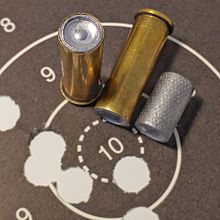Куля з порожнистою основою
Куля з порожнистою основою це куля яка розширюється і має порожнину, що допомагає кулі розширитися під час пострілу та закрити канавки стволу для кращої обтюрації.[1][2] Також вона покращує аеродинамічну стабільність та точність оскільки вага кулі зміщена в передню частину.


Історія ред.
Двом людям приписують винахід кулі з порожнистою основою: капітану французької армії Клоду-Етьєну Мініє та Вільяму Грінеру.[3][4][5] Причиною розробки кулі з порожнистою основою була спроба покращити корисність дульнозарядних гвинтівок під димний порох.[1]
Див. також ред.
Бібліографія ред.
- Fadala, Sam (2006). Ramage, Ken (ред.). The Complete Blackpowder Handbook (вид. 5th). Iola, Wisconsin: Krause Publications. ISBN 978-0-89689-390-0.
Примітки ред.
- ↑ а б Fadala, 2006. p. 144. Quote: "Several undersized conical bullets came to the fore, but the one making in most often into books on gun history is the Minie. Not only is this bullet undersized for improved ease of loading, but upon firing it engages the rifling because of the phenomenon noted several times in this book–obturation."
- ↑ Fadala, 2006. p. 144. Quote: "The bullet at rest (inertia) tends to remain at rest even when bumped in the behind by a terrific force delivered by the expanding gas of the detonated powder charge. Now if that bullet had a hollow base resulting in a “skirt,” the force of gases could expand that skirt to make contact with the rifling."
- ↑ Fadala, 2006. p. 144. Quote: "There is another problem with Minie's claim to have invented the hollow-base conical bullet. Greener, a well-known gunner of his era, claimed that he invented the bullet credited to Minie. And it may be so. The English courts were satisfied that Greener was right, awarding him damages. The English government would never have doled out the cash if Greener could not prove his case."
- ↑ Fadala, 2006. p. 392. Quote: "The story of W. Greener and W.W. Greener runs concurrently. To this day, W.W. Greener's book, The Gun, is read with enthusiasm by students of firearms. W.W. Greener was the son of W. Greener (William), who was known as an experimenter in his time."
- ↑ Fadala, 2006. p. 392. Quote: "W. Greener also invented the hollow-base bullet credited to Captain C.E. Minie of the French Army. To this day, we call that blackpowder projectile type the Minie ball. But in fact, W. Greener won a lawsuit proving that his hollow-base bullet came first. Bucknell reported that W. Greener's “greatest achievement in gunnery was the discovery of the expanding principle for muzzle-loading rifle bullets.”"